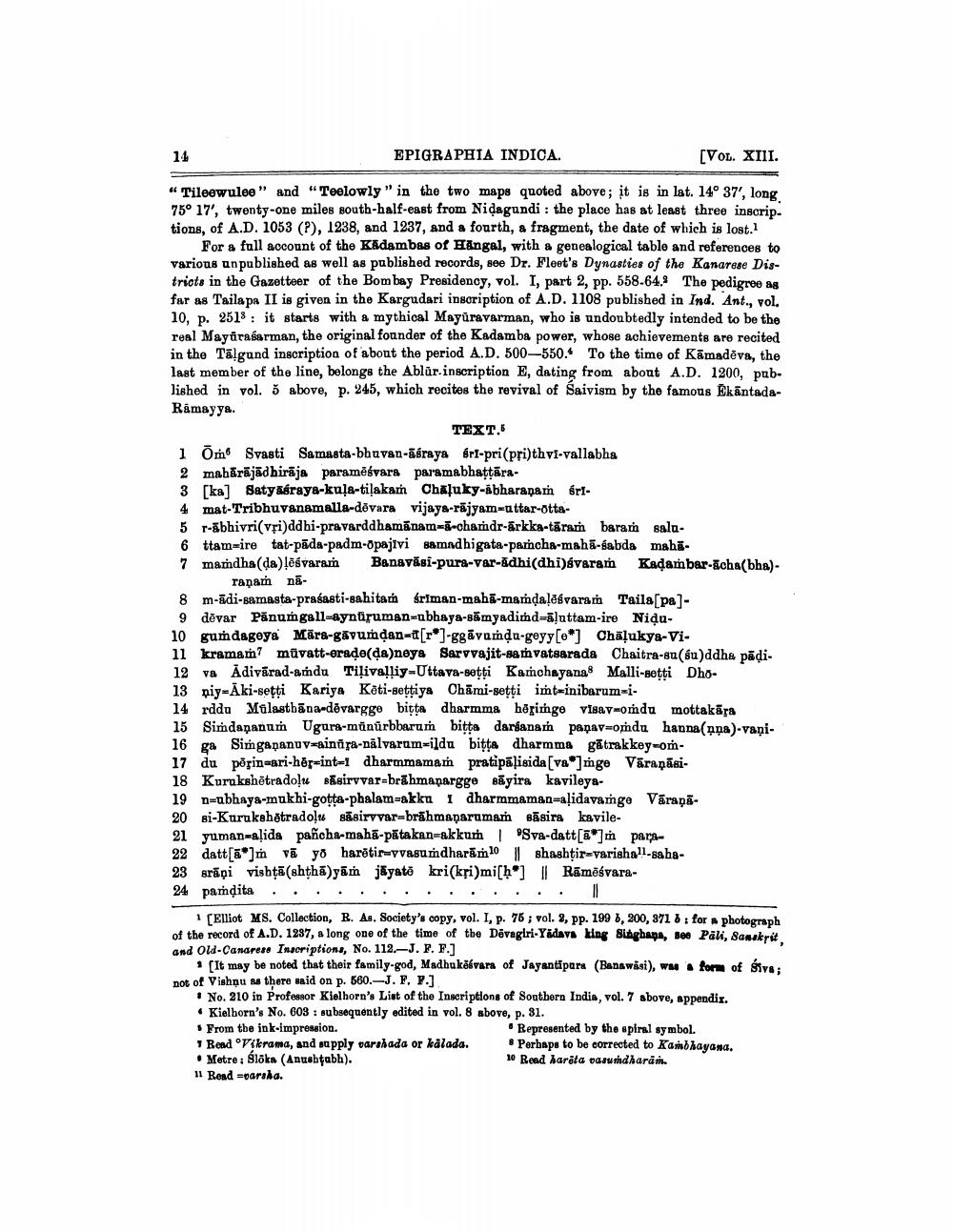________________
14
EPIGRAPHIA INDICA.
[VOL. XIII.
"Tileewulee" and "Teelowly" in the two maps quoted above; it is in lat. 14° 37′, long 75° 17', twenty-one miles south-half-east from Niḍagundi : the place has at least three inscriptions, of A.D. 1053 (P), 1238, and 1237, and a fourth, a fragment, the date of which is lost.1
For a full account of the Kadambas of Hangal, with a genealogical table and references to various unpublished as well as published records, see Dr. Fleet's Dynasties of the Kanarese Districts in the Gazetteer of the Bombay Presidency, vol. I, part 2, pp. 558-64.3 The pedigree as far as Tailapa II is given in the Kargudari inscription of A.D. 1108 published in Ind. Ant., vol. 10, p. 2518: it starts with a mythical Mayuravarman, who is undoubtedly intended to be the real Mayurasarman, the original founder of the Kadamba power, whose achievements are recited in the Talgund inscription of about the period A.D. 500-550. To the time of Kamadeva, the last member of the line, belongs the Ablur.inscription E, dating from about A.D. 1200, published in vol. 5 above, p. 245, which recites the revival of Saivism by the famous ĒkāntadaRamayya.
TEXT.
1 Ōm Svasti Samasta-bhuvan-asraya érl-pri(pri)thvi-vallabha
2 mahārājādhirāja paramēśvara paramabhaṭṭāra
3 [ka] Satyasraya-kula-tilakam Chaluky-abharapaṁ śrl
4 mat-Tribhuvanamalla-devara vijaya-rajyam-uttar-ötta
5 r-abhivri(vri)ddhi-pravarddhamanam-a-chamdr-arkka-taram baram salu
6 ttam-ire tat-pada-padm-opajivi samadhigata-pamcha-maha-sabda mahā7 mamdha (da) lesvaram Banavasi-pura-var-adhi(dhi)svaram
rapaṁ nā
8 m-adi-samasta-prasasti-sahitam śrīman-mahā-maṁḍaléévaram Taila[pa]
9 devar Panumgall-aynfruman-ubhaya-samyadimd-alattam-ire Niḍu
Kadambar-acha(bha)
10 gumdageya Mara-gavumḍan-a[r]-ggavamḍu-geyy[e*] Chalukya-Vi11 kramam müvatt-eraḍe(da)neya Sarvvajit-samvatsarada Chaitra-su(su)ddha paḍi
12 va Adivarad-amdu Tilivalliy-Uttava-setti Kamchayanas Malli-setti Dho
13 piy-Aki-setti Kariya Koti-settiya Chami-setți imt-inibarum-i
14 rddu Mülasthana-dēvargge bitta dharmma hegimge visav omdu mottakāṛa 15 Simdapanum Ugura-münürbbarum biṭṭa darsanam papav=omdu hanna(npa)-vani16 ga Simgapanuv-ainura-nālvarum-ildu bitta dharmma gatrakkey-om
17 du porin-ari-her-int-1 dharmmamam pratipalisida [va*]mge Varapāsi18 Kurukshetradolu sasirvvar-brahmapargge sayira kavileya
19 n-ubhaya-mukhi-gotta-phalam-akku 1 dharmmaman-alidavaṁge Varaṇā20 si-Kurukshetradoļu sasirvvar-brāhmaṇarumaṁ sasira kavile
21 yuman-alida pañcha-maha-patakan-akkum | Sva-datt [*]m para
22 datt [a]m va yo harētir-vvasumdharam10 | shashtir-varisha-saha23 srāpi vishṭā (shṭhā)yām jāyato kri(kri)mi[h] || Rāmēśvara
24 pamḍita
1 [Elliot MS. Collection, R. As. Society's copy, vol. I, p. 76; vol. 2, pp. 199 6, 200, 371 6: for a photograph of the record of A.D. 1237, a long one of the time of the Devagiri-Yadava king Singhapa, see Pali, Sanskrit, and Old-Canarese Inscriptions, No. 112.-J. F. F.]
[It may be noted that their family-god, Madhukeévara of Jayantipara (Banawasi), was a form of Siva; not of Vishnu as there said on p. 560.-J. F. F.]
No. 210 in Professor Kielhorn's List of the Inscriptions of Southern India, vol. 7 above, appendix.
Kielhorn's No. 603 : subsequently edited in vol. 8 above, p. 31.
s From the ink-impression.
7 Read Vikrama, and supply varshada or kalada. Metre: Ślōka (Anushtabh).
11 Read varsha.
Represented by the spiral symbol.
Perhaps to be corrected to Kambhayana.
10 Read harita vasundharam.




